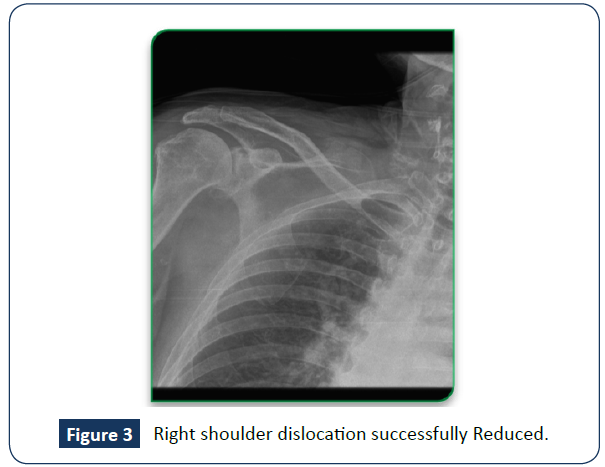Axillary Vein Compression Secondary to Right Shoulder Dislocation with No History of Trauma
M.Bilal, M.Shahzad, P.Kelly and M.Molloy
DOI10.36648/2471-9781.21.7.279
M.Bilal1, M.Shahzad2*, P.Kelly1 and M.Molloy1
1Wexford General Hospital, Republic of Ireland
2St Vincent University Healthcare Group, Elm Park, Dublin 4, Ireland
- *Corresponding Author:
- M.Shahzad
St Vincent University Healthcare Group, Elm Park, Dublin 4, Ireland
Tel: +0035312713072
E-mail: nimih70@icloud.com
Received Date: May 18, 2021; Accepted Date: May 20, 2021; Published Date: June 16, 2021
Citation: Bilal M, Shahzad M, Kelly P, Molloy M (2021) Axillary Vein Compression Secondary to Right Shoulder Dislocation with No History of Trauma. J Hosp Med Manage Vol.7 No.6:279.
Introduction
A 76-years old male nursing home resident was brought to the Emergency Department with blue discoloration of his right upper limb associated with swelling. This was noticed by the nursing staff before ambulance transfer. The nursing staff denied any history of trauma. Patient had right sided weakness and was not able to speak due to recent history of stroke. On examination patient was haemodynamically stable, right upper extremity skin was intact with bluish discoloration associated with mild swelling as compared to the left one (Figure 1). There was no tenderness on palpation and his radial, ulnar and brachial pulses were not palpable. His capillary refill was approximately 4 sec, O2 saturation on his right index finger measure 80% compared to 95% on the left one.
Past Medical History
1. Recent Stroke with residual right sided weakness and aphasia
2. Hypertension
3. Type 2 Diabetes Mellitus
Investigations
1. FBC: Normal
2. Biochemistry: Normal
3. ECG: Normal sinus rhythm
4. Xray Right shoulder: Anterior dislocation of right shoulder joint (Figure 2)
5. Xray Right shoulder post-reduction: Successful reduction of right shoulder joint (Figure 3)
Management
1. Orthopedic review
2. Successful reduction of right shoulder.
Blue right upper limb returned to normal pink color and pulses were palpable after right shoulder dislocation was successfully reduced (Figure 4).
Discussion
Patients in nursing home are at risk of injuries associated with hoist equipment when they are being moved in the nursing home with the help of hoist [1]. Use of hoist has become an integral part of delivering health and social care services. Although the use of hoist can reduce musculoskeletal risks of injuries but there are risks associated with it [2]. Each year a significant numbers of incidents are reported in which people have been injured using hoist equipment. Falls during hoisting patients have resulted in severe injuries from broken bones to fatalities.
References
- Havidich JE, Cravero JP (2012) The current status of procedural sedation for pediatric patients in out-of-operating room locations. Curr Opin Anaesthesiol 25: 453-460.
- Lalwani K, Michel M (2005) Pediatric sedation in North American children’s hospitals: a survey of anesthesia providers. Pediatranesth 15: 209-213.
Open Access Journals
- Aquaculture & Veterinary Science
- Chemistry & Chemical Sciences
- Clinical Sciences
- Engineering
- General Science
- Genetics & Molecular Biology
- Health Care & Nursing
- Immunology & Microbiology
- Materials Science
- Mathematics & Physics
- Medical Sciences
- Neurology & Psychiatry
- Oncology & Cancer Science
- Pharmaceutical Sciences




